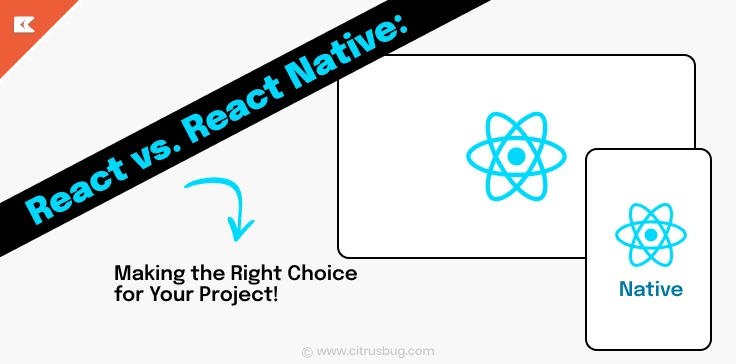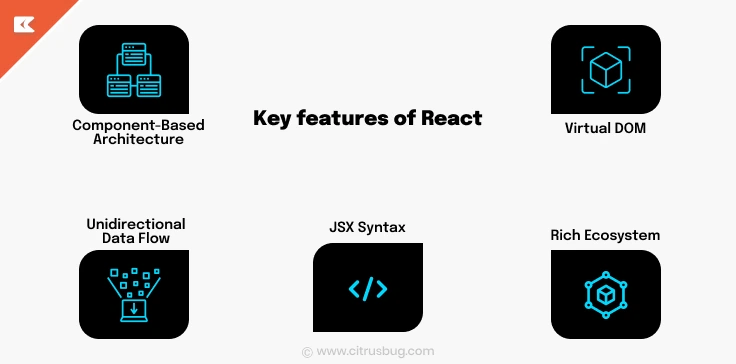React vs. React Native: Making the Right Choice for Your Project
- September 18, 2024
-
3373 Views
- by Ishan Vyas
Table of Contents
- Understanding React
- Challenges with React
- Why Developers Love React
- Diving into React Native
- Key Features of React Native
- Challenges with React Native
- When to Choose React: Perfect for Web-Centric Projects
- When to Choose React Native: Ideal for Mobile-First Strategies
- React Vs. React Native Comparison
- Making the Right Choice for Your Project
- Next Steps?
When it comes to building apps, choosing the correct and intelligent technology is the key. React vs. React Native is a common debate for developers aiming to create dynamic as well as efficient apps. In this article, we will talk about the differences between the above two and help you decide which one is the best fit for your next project. React and React Native, both from Meta (formerly Facebook), are strong but actually serve different purposes. React is mainly used in building dynamic apps with reusable components and a virtual DOM for speedy updates.
On the other hand, what React Native does is make use of React’s ideas but concentrates on mobile app development. This enables developers to use a single codebase to create cross-platform applications with a native appearance and feel. So, if you are looking for the technology to use for your next project, it is very important to start at the right foot. It is important to learn the pros and cons of each technology and then start on with the development part.
Understanding React
React, also called ReactJS, is a free JavaScript library used to make single-page applications. It’s very popular for building user interfaces (UI) for both websites and mobile apps. Facebook created and has supported React since 2011, and it has become very popular.
React helps developers make fast, flexible, and easy-to-use mobile and web applications. It also automates the design process, enabling developers to build whatever they envision without strict guidelines. ReactJS developers can easily integrate plugins or libraries with existing code, allowing them to develop fast, scalable, and straightforward web applications.
With Facebook’s React JavaScript package, web developers can now build lively and interactive websites. React lets developers create small, reusable pieces called components, which can be combined to make complex websites. This approach makes coding easier and faster because developers can reuse parts of their code.
The virtual DOM, a top feature of React, speeds up the app by updating only the changed parts of the user interface instead of the whole page. This makes the app faster and smoother. Also, React’s one-way data flow makes it easier to test and fix bugs.
React has many libraries and tools that enhance its features. React offers the flexibility and capacity to create cutting-edge, responsive online applications, regardless of the complexity of the application.
Challenges with React
Like any technology, React had some challenges when it started.
- Complexity: It was complex and hard for beginners to learn because there weren’t many learning resources.
- New Updates: New trends and ideas in React were coming up almost every day, making it hard to keep the documentation up-to-date. But now, things are better. Updates are announced well in advance, and there are helpful tools like Create React App.
Why Developers Love React
A well-liked technology for creating websites and apps is React. Because it allows them to design reusable elements, which expedites and simplifies their job, developers adore it. React also makes websites more visible in search results, increasing their visibility to a wider audience. It is adaptable to many tasks and integrates well with other tools.
Additionally, React boasts a large community with a wealth of resources, making it easy for developers to obtain support and answers. React is a favorite among developers because of all these characteristics.
Here are some key reasons why developers love React:
- Component-Based Architecture: React lets developers create small, self-contained pieces of an app that handle their own data. These pieces can be reused in different parts of the app, making the code easier to manage and update.
- Virtual DOM: React uses virtual DOM to speed up your application.Basically, instead of reloading the entire page, it only updates the parts that have changed. This helps the app run more smoothly and efficiently.
- Unidirectional Data Flow: React uses one-way data binding, which means data moves in just one direction. This makes it simpler to track and fix issues, and helps you understand the app’s state better.
- JSX Syntax: JSX is a JavaScript extension that helps to write code within JavaScript just like HTML. This makes the code easy to read and write.
- Rich Ecosystem: React has a large collection of libraries, tools, and a supportive community. This provides developers with many tools to make React more powerful and make development easier
Diving into React Native
Hot reloading in React Native lets developers see their code changes right away without restarting the whole app. This makes them work faster and more efficiently.
React Native also has a strong collection of tools and plugins that let developers customize the framework and connect it with many other services. The strong community support and extensive documentation further simplify the learning curve and troubleshooting.
Key Features of React Native
React Native is popular for mobile app development because it has powerful features and makes the process easier. Here are some key points:
- Modular Architecture: The code can be divided into modules, making updates and collaboration easier.
- Rich Ecosystem and Libraries: There are many libraries and plugins available, so developers don’t have to build everything from scratch.
- Strong Community Support: A large, active community provides resources, tutorials, and support, helping with continuous improvement and innovation.
These features help developers create high-quality mobile apps that work well on different platforms.
Challenges with React Native
React Native also has some challenges. They are as follows:
- Missing Modules: It lacks some special modules for specific platforms, so you might need a native developer to create them.
- Navigation Issues: The navigation isn’t always smooth, which can affect user experience.
- Weak Animation Engine: The animation engine isn’t very powerful, making complex animations harder to achieve.
- Performance: Completely native apps may have better performance than extremely sophisticated ones.
Because it lets you use the same code for both iOS and Android, React Native is still a popular option for developing mobile apps despite these drawbacks.
When to Choose React: Perfect for Web-Centric Projects
React is an excellent choice for projects that are primarily web-centric. Here are some scenarios where React shines:
React is great for various types of web projects. Here’s why:
- Single-Page Applications: React is great for apps that need to be fast and responsive. Its virtual DOM helps make updates quick and smooth.
- Dynamic Web Applications: React is good for projects with lots of user interactions and changing content. It makes managing complex user interfaces easier.
- Reusable Parts: With React, you can make parts of your app that you can use again and again. This makes it easier to take care of big apps.
- Better for Search Engines: React can run on the server, which helps your website show up better on search engines like Google.
- Works with Other Tools: React can work well with other tools and frameworks, making it flexible for different web development needs.
- Big Community: React has a large community with lots of resources, libraries, and tools to help you build your app faster and solve common problems.
- Using React for web projects gives you a strong, flexible, and efficient set of tools to build high-quality web applications.
When to Choose React Native: Ideal for Mobile-First Strategies
React Native is a powerful choice for projects that prioritize mobile experiences. Here are some scenarios where React Native excels:
- Cross-Platform Mobile Apps: It reduces development time and costs significantly. Did you know? React Native uses ideas from React to make mobile apps. It helps programmers create apps that work on both iOS and Android with the same code. This saves time and effort. One big advantage is that React Native gives apps a real native look and feel. This leverages existing skills and reduces the learning curve.
- Consistent User Experience: React Native is great for projects that need to look and work the same on different platforms. It makes sure the design and features are uniform, which makes users happy. This consistency gives users a smooth and enjoyable experience, no matter what platform they use.
Choosing React Native for mobile-first strategies ensures that you can deliver high-quality, performant mobile applications efficiently, while also leveraging the benefits of a unified codebase and a strong developer community.
React Vs. React Native Comparison
To put it simply, React and React Native are not really competitors. They’re both JavaScript tools but serve different purposes. Which one you should choose depends on what type of product you want to develop. React, on the other hand, it’s a library. A library is a collection of pre-composed rules and routines that a developer can use instead of writing every line of code from scratch. Libraries cover common use cases and can be incorporated into frameworks.
Frameworks are generally more complex than libraries. React Native was built as a framework. When using it, the developer gets a set of rules and mechanisms ready to be built upon, serving as a sort of support structure.
Making the Right Choice for Your Project
The particular requirements and objectives of your project will choose which of React vs. React Native to use. A strong library for creating responsive and dynamic web apps is called React. Because of its vast ecosystem and component-based architecture, it is perfect for web applications requiring great performance.
React Native is designed for making mobile apps. It lets you create apps that work on both iOS and Android with one set of code, saving time and money. It’s perfect for projects where you need a great user experience on different devices.
The choice should ultimately be made in light of the needs of your project, the intended audience, and the availability of resources. React is your best option if you require a strong online presence. When it comes to building mobile applications, React Native provides the resources and adaptability you need to be successful.
By now, you must have gained a good understanding of React and React Native.
As far as these technologies go, their final product platforms differ, but their development processes are based on comparable ideas. Facebook introduced these frameworks, which are open-sourced and integrate seamlessly with JavaScript. Developers use all of these for surprisingly varied purposes.
It will actually be simpler to learn another framework if you can master either React or React Native. But you need to be familiar with React in order to create a React Native application. However, it doesn’t stop there! Since React Native offers little support for native applications,you must learn more about them in-depth.
Next Steps?
Consider collaborating with organizations that specialize in React development to achieve the greatest outcomes. These professionals can offer insightful advice and assist you in selecting the best technology for your needs. They can also help with every step of the development process, from initial design and planning to execution and continuing upkeep. You can make sure that your project is finished quickly and according to your high standards by making use of their knowledge.
Therefore, deciding between React vs. React Native depends on the particular requirements and objectives of your project, whether you’re creating a dynamic website or a seamless mobile app. You can choose a technology that will guarantee your project is finished effectively and to your satisfaction by being aware of its advantages and working with knowledgeable experts. Seek professional guidance to choose the best course of action and ensure the success of your project.





 SaaS Development
SaaS Development Web Application Development
Web Application Development Mobile Application Development
Mobile Application Development Custom Software Development
Custom Software Development Cloud Development
Cloud Development DevOps Development
DevOps Development MVP Development
MVP Development Digital Product Development
Digital Product Development Hire Chatbot Developers
Hire Chatbot Developers Hire Python Developers
Hire Python Developers Hire Django Developers
Hire Django Developers Hire ReactJS Developers
Hire ReactJS Developers Hire AngularJS Developers
Hire AngularJS Developers Hire VueJS Developers
Hire VueJS Developers Hire Full Stack Developers
Hire Full Stack Developers Hire Back End Developers
Hire Back End Developers Hire Front End Developers
Hire Front End Developers AI Healthcare Software Development & Consulting
AI Healthcare Software Development & Consulting Healthcare App Development
Healthcare App Development EHR Software Development
EHR Software Development Healthcare AI Chatbot Development
Healthcare AI Chatbot Development Telemedicine App Development Company
Telemedicine App Development Company Medical Billing Software Development
Medical Billing Software Development Fitness App Development
Fitness App Development RPM Software Development
RPM Software Development Medicine Delivery App Development
Medicine Delivery App Development Medical Device Software Development
Medical Device Software Development Patient Engagement Software Solutions
Patient Engagement Software Solutions Mental Health App Development
Mental Health App Development Healthcare IT Consulting
Healthcare IT Consulting Healthcare CRM Software Development
Healthcare CRM Software Development Healthcare IT Managed Services
Healthcare IT Managed Services Healthcare Software Testing services
Healthcare Software Testing services Medical Practice Management Software
Medical Practice Management Software Outsourcing Healthcare IT Services
Outsourcing Healthcare IT Services IoT Solutions for Healthcare
IoT Solutions for Healthcare Medical Image Analysis Software Development Services
Medical Image Analysis Software Development Services Lending Software Development Services
Lending Software Development Services Payment Gateway Software Development
Payment Gateway Software Development Accounting Software Development
Accounting Software Development AI-Driven Banking App Development
AI-Driven Banking App Development Insurance Software Development
Insurance Software Development Finance Software Development
Finance Software Development Loan Management Software Development
Loan Management Software Development Decentralized Finance Development Services
Decentralized Finance Development Services eWallet App Development
eWallet App Development Payment App Development
Payment App Development Money Transfer App Development
Money Transfer App Development Mortgage Software Development
Mortgage Software Development Insurance Fraud Detection Software Development
Insurance Fraud Detection Software Development Wealth Management Software Development
Wealth Management Software Development Cryptocurrency Exchange Platform Development
Cryptocurrency Exchange Platform Development Neobank App Development
Neobank App Development Stock Trading App Development
Stock Trading App Development AML software Development
AML software Development Web3 Wallet Development
Web3 Wallet Development Robo-Advisor App Development
Robo-Advisor App Development Supply Chain Management Software Development
Supply Chain Management Software Development Fleet Management Software Development
Fleet Management Software Development Warehouse Management Software Development
Warehouse Management Software Development LMS Development
LMS Development Education App Development
Education App Development Inventory Management Software Development
Inventory Management Software Development Property Management Software Development
Property Management Software Development Real Estate CRM Software Development
Real Estate CRM Software Development Real Estate Document Management Software
Real Estate Document Management Software Construction App Development
Construction App Development Construction ERP Software Development
Construction ERP Software Development








